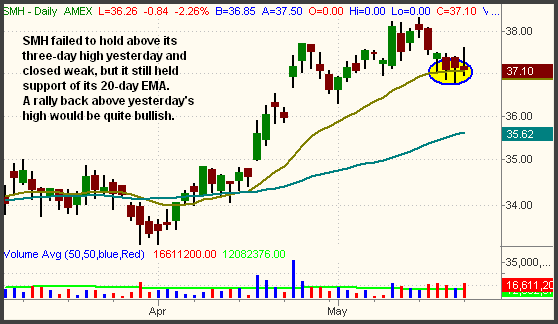| The Wagner Daily ETF Report for May 22 |
| By Deron Wagner |
Published
05/22/2007
|
Stocks
|
Unrated
|
|
|
|
The Wagner Daily ETF Report for May 22
As anticipated, a continuation of institutional sector rotation enabled small-caps to zoom higher yesterday, while the blue chips languished behind. The Russell 2000 Index gained 1.2% and the Nasdaq Composite advanced 0.8%, but the Dow Jones Industrial Average slipped 0.1%. The S&P 500 was higher by 0.2% and the S&P Midcap 400 rallied 0.8%. Each of the major indices showed strength in the morning, then pulled back off their highs in the afternoon.
Turnover faded a bit yesterday. Total volume in the NYSE came in 9% lower than the previous day's level, as volume in the Nasdaq slipped 2%. Not only did volume decline slightly from the previous day's level, but it also once again came in below its 50-day average level. Of the past fourteen sessions, volume in the NYSE has exceeded its 50-day average only two times. While this may not seem like a big deal on the surface, it's interesting to note that the new high territory of both the S&P and Dow has been occurring on lighter than average volume for most of the past three weeks. Market internals were positive in both exchanges, but more so in the Nasdaq. Advancing volume in the NYSE exceeded declining volume by a margin of just over 3 to 2. The Nasdaq ratio was positive by more than 3 to 1.
Bells and whistles went off on CNBC and other financial media outlets when the S&P 500 rallied above its all-time closing high of 1,527 intraday, but the party was short-lived because the index failed to close above that level. While this certainly does not mean the index won't finish at a new high in the next day or two, yesterday's feeble attempt caused the S&P to form a bearish "inverted hammer" candlestick pattern on its daily chart:

Frankly, we couldn't care less if the S&P manages to close at a new record high or not. With the S&P already trading at a new 52-week high for quite some time, 1,527 is just a number that is not much different than 1,525 or 1,526. Nevertheless, the media circus has created quite a frenzy about whether or not the S&P will follow in the footsteps of the Dow by marching to a new historical high. Because of all the hoopla, the 1,527 level is likely to be quite pivotal as an area of support or resistance in the coming weeks.
Although the popular financial media has been more obsessed with the record highs continually being set by the Dow Jones, as well as the S&P 500's current attempt, the reality is that leadership in aggressive growth small-caps is more important for the long-term health of any market. In yesterday's newsletter, we pointed out the initial signs of sector rotation into small-cap stocks that we initially noticed in last Friday's session. The small-cap Russell 2000 followed through nicely on that strength yesterday, outperforming both the S&P and Dow by a wide margin. Over the past month, the relative weakness displayed by the Russell was one of our biggest concerns for the broad-based rally. As such, we are pleased to see a bit of money flowing out of the Dow and back into the Russell. As you can see on the chart below, the iShares Russell 2000 (IWM) bounced perfectly off its 50-day MA and closed just shy of a record high. Notice yesterday's volume surge as well:

If IWM rallies above yesterday's high, it will correspond to a breakout from a five-week base of consolidation. Depending on how long the institutional rotation into small-caps continues, bullish momentum could push IWM significantly higher if it manages to break out and close at a new high. We will be watching IWM for a potential long entry if it breaks out.
The Semiconductor HOLDR (SMH) was another ETF we analyzed in yesterday's Wagner Daily. As expected, SMH attempted to follow through on the bounce off its 20-day EMA, but weakness in the afternoon caused it to close in the middle of the previous day's range. Still, SMH continues to hold above its 20-day EMA:

We bought SMH when it rallied above the May 18 high, but sold it a few hours later when it failed to hold above the previous day's high. It subsequently closed lower. If we buy an ETF in such an overall bullish market and it fails to immediately move in the right direction, there's no sense holding it overnight. However, we will be watching SMH for a potential re-entry today, depending on the performance of the Semiconductor Index ($SOX).
Deron Wagner is the Founder and Head Trader of both Morpheus Capital LP, a U.S. hedge fund, and Morpheus Trading Group, a trader education firm launched in 2001 that provides daily technical analysis of the leading ETFs and stocks. For a free trial to the full version of The Wagner Daily or to learn about Wagner's other services, visit MorpheusTrading.com or send an e-mail to deron@morpheustrading.com.
|